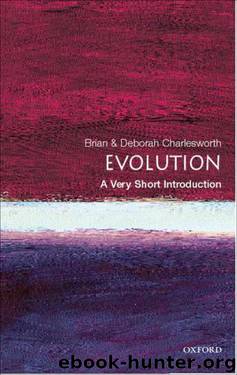Evolution by Brian Charlesworth & Deborah Charlesworth

Author:Brian Charlesworth & Deborah Charlesworth [Charlesworth, Brian & Charlesworth, Deborah]
Language: eng
Format: epub, mobi
ISBN: 9780192802514
Publisher: Oxford University Press
Published: 2003-08-28T08:00:00+00:00
The concept of fitness is often misunderstood. When biologists try to illustrate the meanings of this term, they often use examples that correspond with our everyday use of the word fitness, such as the speed of antelopes. There is less danger of confusion if we think of characteristics like the lightweight bones of birds, with their hollow centres and strengthening cross-struts (Figure 14). The theory of natural selection accounts for such apparently well-designed structures by pointing out that, when flight was evolving, lighter-boned individuals would have had slightly higher chances of survival than others. If their descendants inherited lighter bones, the characteristic would increase in its representation in the population over the generations. This is just the same as artificial selection by breeders of the fastest dogs, which has given all greyhounds long, thin legs. These are mechanically more efficient than short ones, and greyhounds’ legs closely resemble those of antelopes and other fast-running animals, which have evolved by natural selection. We can describe natural and artificial selection perfectly well without using the word fitness. Natural selection implies nothing more than that certain heritable variants may be preferentially passed on to future generations. Individuals carrying genes that lower their survival or reproductive success will generally not pass on those genes to the same extent as other individuals whose genes give higher survival or reproductive ability. The term fitness is merely a useful short-cut to help express briefly the idea that characteristics sometimes affect organisms’ chances of surviving and/or reproducing, without having to specify a particular characteristic. It is also useful in making mathematical models of the way selection affects the genetic make-up of a population. Conclusions from these models provide a rigorous underpinning for many of the statements that we make in this chapter, but we will not describe them here.
Download
Evolution by Brian Charlesworth & Deborah Charlesworth.mobi
This site does not store any files on its server. We only index and link to content provided by other sites. Please contact the content providers to delete copyright contents if any and email us, we'll remove relevant links or contents immediately.
Sapiens: A Brief History of Humankind by Yuval Noah Harari(14212)
Sapiens by Yuval Noah Harari(5281)
Pale Blue Dot by Carl Sagan(4886)
Homo Deus: A Brief History of Tomorrow by Yuval Noah Harari(4801)
Livewired by David Eagleman(3663)
Origin Story: A Big History of Everything by David Christian(3631)
Brief Answers to the Big Questions by Stephen Hawking(3356)
Inferior by Angela Saini(3260)
Origin Story by David Christian(3132)
Signature in the Cell: DNA and the Evidence for Intelligent Design by Stephen C. Meyer(3055)
The Gene: An Intimate History by Siddhartha Mukherjee(3029)
The Evolution of Beauty by Richard O. Prum(2925)
Aliens by Jim Al-Khalili(2776)
How The Mind Works by Steven Pinker(2714)
A Short History of Nearly Everything by Bryson Bill(2616)
Sex at Dawn: The Prehistoric Origins of Modern Sexuality by Ryan Christopher(2472)
From Bacteria to Bach and Back by Daniel C. Dennett(2432)
Endless Forms Most Beautiful by Sean B. Carroll(2414)
Who We Are and How We Got Here by David Reich(2385)
